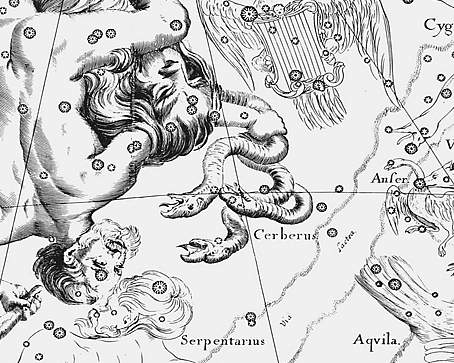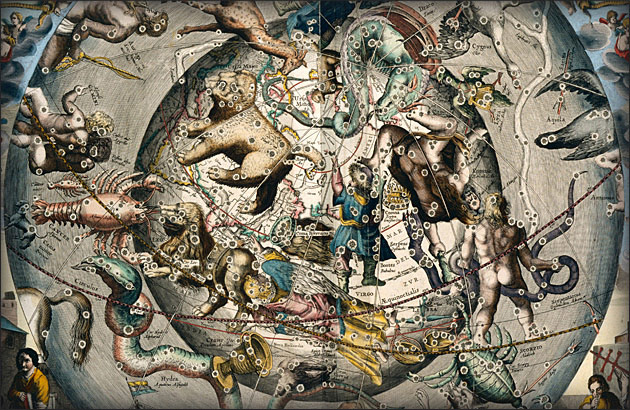The Hound of Hel and the River of Poison
by Peter Krüger
©2012
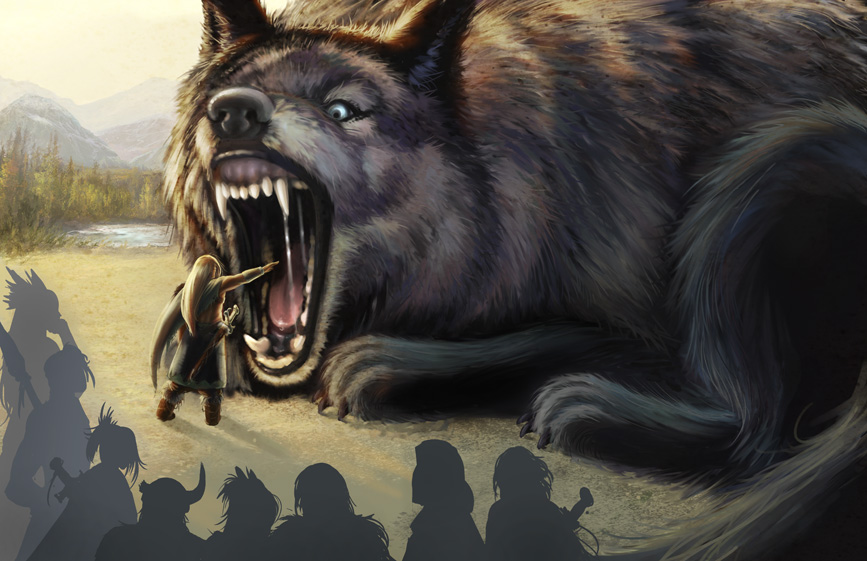
Return to Germanic Astronomy
We have seen that many Eddic
figures can be identified as star constellations by comparing them with
Greek/Roman constellations or sometimes by constellations mentioned in
the cuneiform tablet MUL.APIN from Mesopotamia.
Surely
the constellation Scorpio, which is easy to find in the starry sky due
to its characteristic shape and bright stars, was also known to the
Germanic tribes. Obviously, however we have to search for another
description as scorpions are not native to central or northern Europe.
The right
trace we might find already in Greek mythology even Greeks were familiar
with scorpions. In the Sumerian Gilgamesh epos there are scorpion men
guarding the gates of the underworld at the zodiac. The same role plays
in Greek mythology the hound Cerberus. If we compare the descriptions of
Cerberus with the picture of Scorpio below and star maps we find
striking similarities: Cerberus is described as a hound bearing several
heads (normally three but often even more), having a serpent-shaped tail
with a serpent head and having additional serpents forming his mane.
"As a
twelfth labour Herakles was to fetch Kerberos (Cerberus) from Haides'
realm. Kerberos had three dog-heads, a serpent for a tail, and along his
back the heads of all kinds of snakes."
The serpent
tail reminds to the stinger of the scorpio and the mane of serpents to
the legs at the side of the scorpion. The three heads might be inspired
by the stars beta-, delta- and pi-Scorpio at the head of Scorpio.
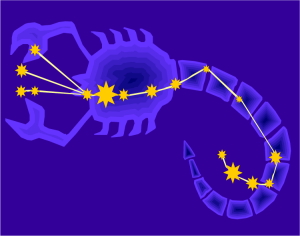
Do we find
in the stars proofs that Cerberus and Garm (or even Fenrir) could be
indeed identical? An answer can bring us a closer investigation of the
hellhound in
Baldr’s draumar
2-3:
|
2. Upp reis
Óðinn, alda gautr, |
2. Then Othin rose, | the enchanter old, And the saddle he laid | on Sleipnir's back; Thence rode he down | to Niflhel deep, And the hound he met | that came from hell. |
|
3. Sá var blóðugr um brjóst framan ok galdrs föður gól of lengi; fram reið Óðinn, foldvegr dunði; hann kom at hávu Heljar ranni. |
3. Bloody he was | on his breast before, At the father of magic | he howled from afar; Forward rode Othin, | the earth resounded Till the house so high | of Hel he reached. |
The
dog is described as having a bloody breast. There could be of course a
very simple explanation, the hellhound is killing men and blood is
dropping on his breast. However, it is extremely interesting to compare
this description with the constellation Scorpio. The brightest star,
alpha-Scorpio, is the red (!) supergiant star Antares. He is called in
Greek also Kardia Scorpiu, in Latin Cor Scorpii, the heart of the
Scorpion. In the cuneiform tablet MUL.APIN Antares is called
GABA.GIR.TAB, the breast of the scorpion. This means the bloody (= red)
breast of the dog might refer to the main star of Scorpio, Antares. The
name Antares itself is explained normally as Anti-Ares, i.e. Anti-Mars.
As the equivalent of Mars in Germanic myth is Tyr (dies Marti – Tuesday)
this might also explain why during Ragnarok the hellhound Garm is
fighting according to Gylfaginning against Tyr.
Interestingly the hellhound Garmr and also the wolf Fenris were not said to have multiple heads like Cerberus. Instead the main characteristic of Fenris in Gylfaginning 34 is to have the mouth wide open with a sword stuck in his jaws.
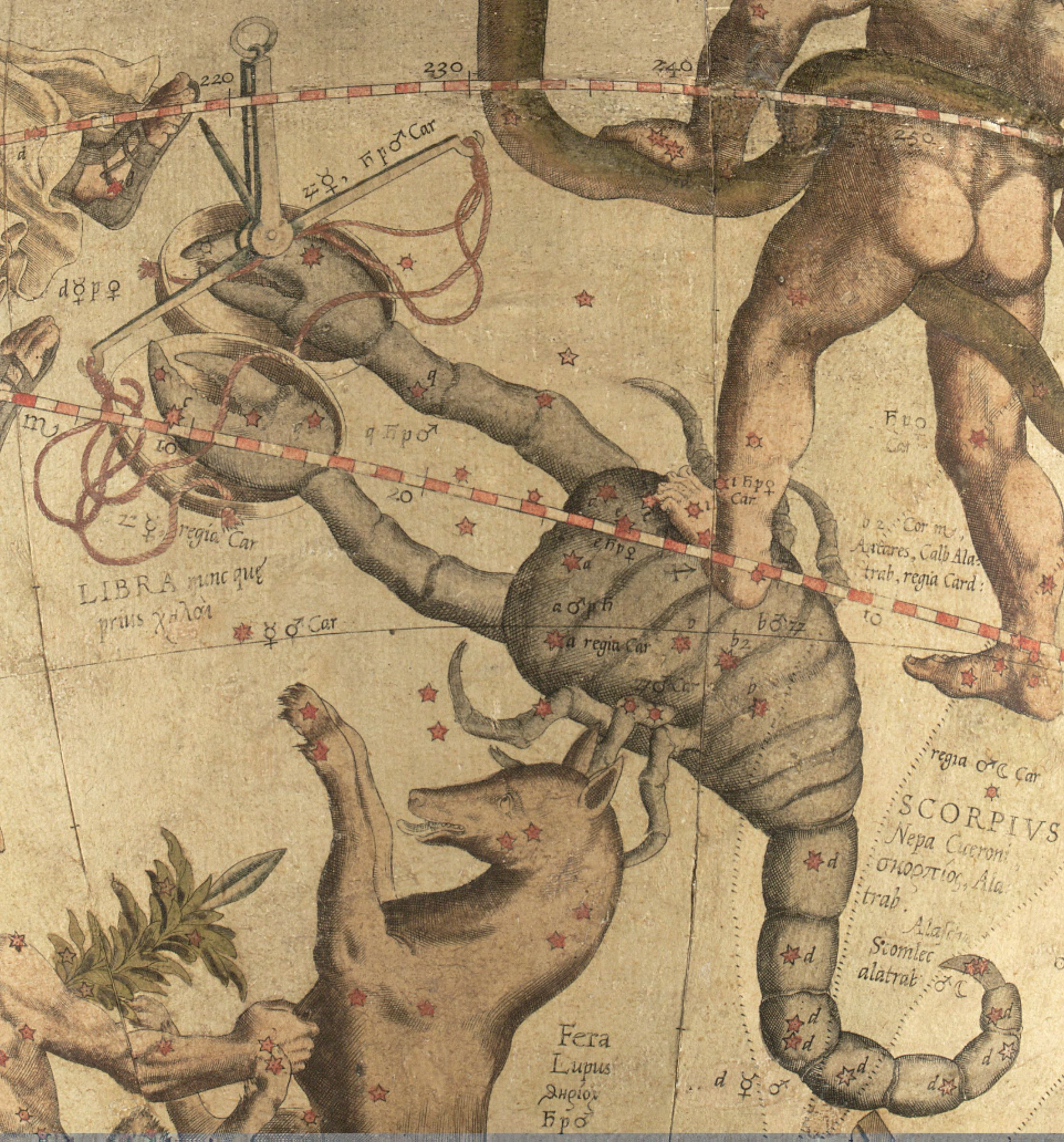 |
This can
again be compared to Scorpio. It might be an echo of the original Scorpio
complete with his two claws, which were later transformed
into the constellation Libra. The cuneiform name GIR.TAB literally means
'the one with the two claws' and this might have once been 'the one with
the two jaws open wide'.
| x |
"When the
Æsir saw that the Wolf was fully bound, they took the chain that was
fast to the fetter, and which is called Gelgja, and passed it through a
great rock--it is called Gjöll--and fixed the rock deep down into the
earth. Then they took a great stone and drove it yet deeper into the
earth--it was called Thviti--and used the stone for a fastening-pin. The
Wolf gaped terribly, and thrashed about and strove to bite them; they
thrust into his mouth a certain sword: the guards caught in his lower
jaw, and the point in the upper; that is his gag. He howls hideously,
and slaver runs out of his mouth: that is the river called Ván; there he
lies till the Doom of the Gods
The place
where Cerberus kept watch was according to some at the mouth of the
Acheron (the border river of the netherworld), and according to others
at the gates of Hades, into which he admitted the shades, but never let
them out again.
Hesiod,
Theogony 769 ff :
"And before
them [the halls of Hades and Persephone] a dreaded hound (deinos
kunos) [Kerberos, Cerberus], on watch, who has no
pity, but a vile stratagem: as people go in he fawns on all, with
actions of his tail and both ears, but he will not let them go back out,
but lies in wait for them and eats them up, when he catches any going
back through the gates."
Pseudo-Apollodorus, Bibliotheca 2, 125 (trans. Aldrich) (Greek mytho-grapher circa 2nd A.D.) :
"Herakles asked Pluto [Hades] for Kerberos (Cerberus), and was told to
take the hound if he could overpower it without using any of the weapons
he had brought with him. He found Kerberos at the gates of Akheron, and
there, pressed inside his armour and totally covered by the lion's skin,
he threw his arms round its head and hung on, despite bites from the
serpent-tail, until he convinced the beast with his choke-hold. Then,
with it in tow, he made his ascent through Troizen. After showing
Kerberos to Eurystheus, he took it back to Hades' realm."
This
location at the gates of Akheron mentioned for Cerberus is very
interesting as the Akheron is normally describes as the river of the
underworld. This is of of highest interest as it has a direct parallel
in Lokasenna:
Loki
spoke:
38. "Be silent,
Tyr!
| for between two men
Friendship thou ne'er couldst fashion;
Fain would I tell | how
Fenrir
once
Thy right hand rent from thee."
Tyr
spoke:
39. "My hand do I lack, | but
Hrothvitnir
thou,
And the loss brings longing to both;
Ill fares the
wolf
| who shall ever await
In fetters the
fall of the
gods."
Loki spoke:
40. "Be silent,
Tyr!
| for a son with me
Thy wife once chanced to win;
Not a penny, methinks, | wast thou paid for the wrong,
Nor wast righted an inch, poor wretch."
Freyr
spoke:
41. "By the mouth of the river | the
wolf
remains
Till the
gods
to
destruction
go;
Thou too shalt soon, | if thy tongue is not stilled,
Be fettered, thou forger of ill."
This
parallel is interesting enough. But are we also able to find the river?
First of all, of course we can’t be sure that the wolf mentioned in
Lokasenna is identical to Garm or Fenrir. Especially as next to Scorpio
there is another possible candidate, the constellation Lupus, literally
the wolf, named as such since oldest days. However, if the wolf would be
Lupus, than we would have a fascinating possibility to explain the
river. There are in principal two possibilities how the mouth of a river
can look like, with or without a delta. If we look again on the picture
of Scorpio (but this time without the claws!) than it could be seen as
having the shape of a river with a delta! In addition there is a very
interesting description of a river in Voluspa 36:
|
“Á fellur austan |
“From the east there pours through poisoned vales With swords and daggers the river Slith.” |
If we bring
this river in connection with the mouth of the river we would find a
very sound theory for the eitrdala. As a scorpion is a poisonous insect
the poisonous dales the river is flowing through sound like an echo of
his poisonous stinger. The saxes and swords might than refer to the legs
that were transferred into the snakes in the Greek tale or to the claws
of the Scorpio.
Besides
Slith there is another river of interest, the river Gjöll with the
bridge Gjallarbru crossing it. In Gyfaginning 34 Fenrir is said to be
bound to a rock called Gjöll and a river called Van is streaming out of
his mouth.
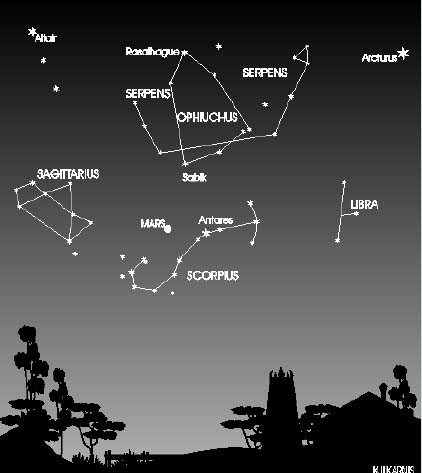
The stinger
of Scorpio is located next to Ophiuchus. In Ophiuchus we found described
the bound Loki, so the poisonous serpent could also be interpreted as
the stinger of Scorpio as in the case of Cerberus.
We find
therefore several possibilities for the hellhound and the wolf. Either
they are identical to Lupus next to the (river) of Scorpio or
(especially as Lupus can’t be seen from middle or northern Europe!) the
wolf and hellhound was interpreted as Scorpio with a river flowing out
of the mouth. We might therefore have two separate interpretations of
Scorpio mingled together: one as a river and one as a wolf or hound.
The
interpretation of Scorpio as a river crossing the zodiac and the Milky
Way mountains sheds also new light on the name Fenrisulfr (regardless of
the above mentioned difficulties of identification). The river with a
delta is surely forming a marsh or fen, giving name to the wolf. As this
fen would be between Scorpio and Virgo this might also explain the term
Fensalir belonging to Frigg.
33. Þó hann
æva hendr né höfuð kembði,
áðr á bál of bar Baldrs andskota;
en Frigg of grét í Fensölum
vá Valhallar. Vituð ér enn - eða hvat?
Aeschylus,
Seven Against Thebes 854 ff :
"But sail
upon the wind of lamentation, my friends, and about your head row with
your hands' rapid stroke in conveyance of the dead, that stroke which
always causes the sacred slack-sailed, black-clothed ship [of Kharon] to
pass over Akheron to the unseen land here Apollon does not walk, the
sunless land that receives all men."
Just behind
of Scorpio we find the constellation of
Sagittarius, normally depicted as an archer with a bow in his hand.
South of it there has been seen a boat, called MA.GUR8 in the MUL.APIN
tablets. The boat could be the stars of Corona Australis.
In Voluspa
just after a description of Garm we find a hint to Sagittarius (here
holding a shield instead of a bow) giving further proof to the
identification. In the strophe is furthermore mentioned an eagle,
Aquila, north of Sagittarius, and the boat of the death, Naglfar.
49. Now Garm
howls loud | before Gnipahellir,
The fetters will burst, | and the wolf run free
Much do I know, | and more can see
Of the fate of the gods, | the mighty in fight.
50. From the
east comes Hrym | with shield held high;
In giant-wrath | does the serpent writhe;
O'er the waves he twists, | and the tawny eagle
Gnaws corpses screaming; | Naglfar is loose.
We will see later in another investigation that the wolf or dog bound or
chained at the gates of the netherworld or the mouth of the river has to be
distinguished from the picture of “the wolf run free” during Ragnarok. The later
one is seen in Leo, the lion together with Hydra, the Midgard serpent both
fighting to the nearby constellations of Orion (Odin) and Taurus (Thor), all
four setting at the same time of year.
